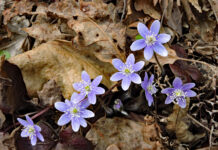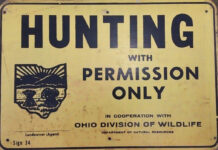By Levi Mercer
As the weather begins cooling and leaves begin falling, there are many folks who head to Ohio’s woods and wetlands in pursuit of a variety of upland wildlife and waterfowl species. While white-tailed deer and wild turkey undoubtedly take the cake as the most highly sought after upland species, there is another critter that is in the back of every hunter’s mind this fall.
Early Ohio squirrel hunting
People have been hunting squirrels longer than most species with records showing a history of squirrel hunting dating back nearly 10,000 years ago, at the end of the last Ice Age.
At one point in Ohio’s early history, populations of squirrels were so plentiful that a law was put in place in 1807 that required all men over the age 18 to kill a minimum of 100 squirrels a year as a means to control the overabundance of squirrels that were wreaking havoc on crops.
Those who delivered 100 squirrel hides to their local county treasurer or township clerk received a $3 tax credit towards their property tax. Those who failed to turn in the required 100 hides were charged a penalty of 3 cents for each pelt they failed to turn in.
While the population numbers have since declined enough to the point that citizens are no longer required under law to kill squirrels, the tradition of Ohio squirrel hunting was born and remains even today.
Squirrel hunting today
During the 2022-23 season, it was reported that 70,322 of Ohio’s licensed hunters entered the woods in pursuit of squirrels. While those numbers are down a bit from years past, rest assure that squirrel hunting is here to stay.
Ohio hunters are permitted to take six squirrels per day from Sept. 1-Jan. 31. These squirrels can be taken from half an hour before sunrise to sunset, and can be gray, red, black or fox squirrels.
Hunting squirrels can be a fun and engaging way for new as well as experienced hunters to get into the woods and connect with the woods around them. Because of the relatively high population of squirrels, and large variety of foods available to them in nut producing trees, the odds of having a successful squirrel hunt is significantly higher than most other species. Where it is somewhat higher stakes to hunt deer or turkey, it is not as big of a deal if you miss a shot on a squirrel. Squirrels are also a very inexpensive and tasty source of fresh meat.
Squirrel hunting techniques
Opinions on the best technique to use when hunting squirrels vary depending on the hunter’s preference as well as the amount of leaf cover at different points in the year. As one who has hunted squirrels myself at different times of the season and in a variety of weather conditions, these are a few of the tips and tricks that I use.
During the early portion of fall, September through early November, it is not at all uncommon to have a significant amount of leaf cover remaining on the trees and day time high temperatures ranging from the 80s to 40s. For this reason, many of my early fall hunts are done using a shotgun and actively walking through the woods.
This means you will have to get a lot closer to the squirrels to get a shot at them, and the odds of them becoming aware of you are much higher. This method relies more on your reflexes combined with your sense of sight and hearing to locate and sight down squirrels that are more than likely actively on the move.
After the leaves fall and the temperatures dip into much cooler daytime high temperatures is when I reach for the rifle when heading into the woods. My personal preference is a .22 caliber rifle with a 9-power adjustable scope, but a .17HMR will work as well.
Rifle hunting is much more oriented around sitting and waiting than shotgun hunting. The best rifle hunts are on clear frosty mornings with lots of sunshine and minimal wind. Squirrels, like most other living creatures, prefer to be as warm as possible. For this reason, you are much less likely to spot squirrels out and about foraging when the weather is exceptionally bad. Squirrels spend the better part of the fall gathering nuts and caching it away for the harshest of winter days, but will usually take a clear winter day as an opportunity to gather more food.
By sitting still and drawing little attention to yourself, you can usually catch them out and about from as far as 100 yards depending on your terrain. This requires a bit more marksmanship and a lot more patience, but can be a great time to take in the beauty of the woods and put your sharpshooting skills to the test.
Preparing your harvest
Now that you have your squirrels, what can you do with them? There are hundreds of different recipes that you can try with squirrel meat online or in some wild game cook books. One of my personal favorite is barbecue pulled squirrel. All that you need to do to make this dish is to separate the meat from the bones using a slow cooker.
Once you have the meat in a crockpot of its own, you can mix your favorite barbecue sauce and serve on buns, over potatoes, or even macaroni and cheese. The only limit to what you can make with squirrel meat is your imagination.
(Levi Mercer is a wildlife and forestry specialist with Guernsey Soil and Water Conservation District. He can be reached at 740-489-5276 ext 6890 or lmercer@guernseycounty.org.)













